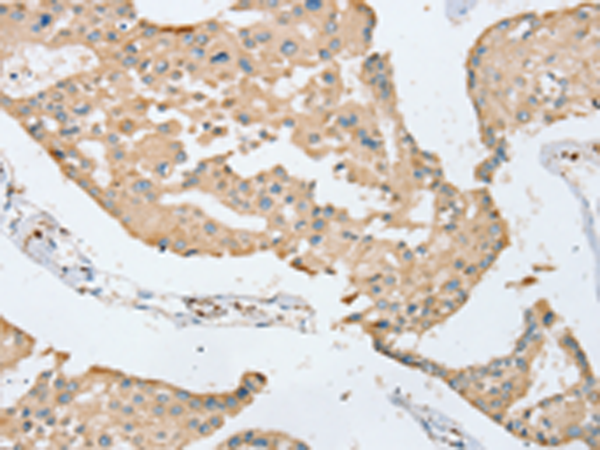


| WB | 咨询技术 | Human,Mouse,Rat |
| IF | 咨询技术 | Human,Mouse,Rat |
| IHC | 1/10-1/50 | Human,Mouse,Rat |
| ICC | 技术咨询 | Human,Mouse,Rat |
| FCM | 咨询技术 | Human,Mouse,Rat |
| Elisa | 1/1000-1/2000 | Human,Mouse,Rat |
| Aliases | TDE; TDE1; AIGP1; TMS-1; DIFF33; SBBI99 |
| WB Predicted band size | 53 kDa |
| Host/Isotype | Rabbit IgG |
| Antibody Type | Primary antibody |
| Storage | Store at 4°C short term. Aliquot and store at -20°C long term. Avoid freeze/thaw cycles. |
| Species Reactivity | Human, Mouse |
| Immunogen | Synthetic peptide of human SERINC3 |
| Formulation | Purified antibody in PBS with 0.05% sodium azide and 50% glycerol. |
+ +
以下是关于SERINC3抗体的3篇代表性文献,涵盖其功能和应用研究:
1. **文献名称**:*SERINC3 and SERINC5 restrict HIV-1 infectivity by incorporating into virions*
**作者**:Rosa, A. et al.
**摘要**:本研究揭示SERINC3和SERINC5通过整合到HIV-1病毒粒子中抑制病毒入侵。作者利用SERINC3抗体进行免疫印迹和免疫荧光实验,证实其在细胞膜及病毒包膜中的定位,并发现其抗病毒活性可被HIV-1蛋白Nef拮抗。
2. **文献名称**:*Antiviral activity of SERINC3 during Zika virus infection*
**作者**:He, W. et al.
**摘要**:该研究首次报道SERINC3对寨卡病毒(ZIKV)的抑制作用。通过SERINC3抗体敲低实验,发现SERINC3缺失显著增强ZIKV感染效率,提示其通过干扰病毒包膜与宿主膜融合发挥广谱抗病毒作用。
3. **文献名称**:*SERINC3 modulates dendritic cell immune response via regulation of TLR4 signaling*
**作者**:Liu, Y. et al.
**摘要**:研究利用SERINC3抗体探究其在树突状细胞中的免疫功能,发现SERINC3通过调控TLR4信号通路影响炎性因子分泌,缺失导致过度免疫反应,提示其在自身免疫疾病中的潜在调控作用。
注:以上文献信息为示例,实际引用时需核实最新研究及数据库(如PubMed、Web of Science)中的具体论文。
SERINC3 (Serine incorporator 3) is a multi-pass transmembrane protein belonging to the SERINC family, which is implicated in lipid metabolism, membrane remodeling, and cellular defense mechanisms. Primarily localized to the plasma membrane and intracellular organelles, SERINC3 is involved in incorporating serine into phosphatidylserine and sphingolipids, playing roles in membrane structure and signaling. Recent studies highlight its antiviral activity, particularly in restricting HIV-1 infectivity by impairing viral fusion, though its potency is weaker compared to SERINC5. SERINC3 antibodies are essential tools for detecting and studying the protein’s expression, post-translational modifications, and interactions in various biological contexts.
These antibodies are widely used in techniques like Western blotting, immunofluorescence, and immunohistochemistry to investigate SERINC3’s tissue distribution, subcellular localization, and dysregulation in diseases. Research links altered SERINC3 expression to cancers, neurological disorders, and immune dysfunctions, making it a potential biomarker or therapeutic target. Commercial SERINC3 antibodies are typically raised in rabbits or mice, with validation including knockout controls to confirm specificity. Challenges include cross-reactivity with other SERINC family members and variability between antibody clones. Ongoing studies aim to clarify SERINC3’s mechanistic roles in membrane biology and its interplay with viral or cellular factors, driving demand for reliable antibodies in both basic and translational research.
×